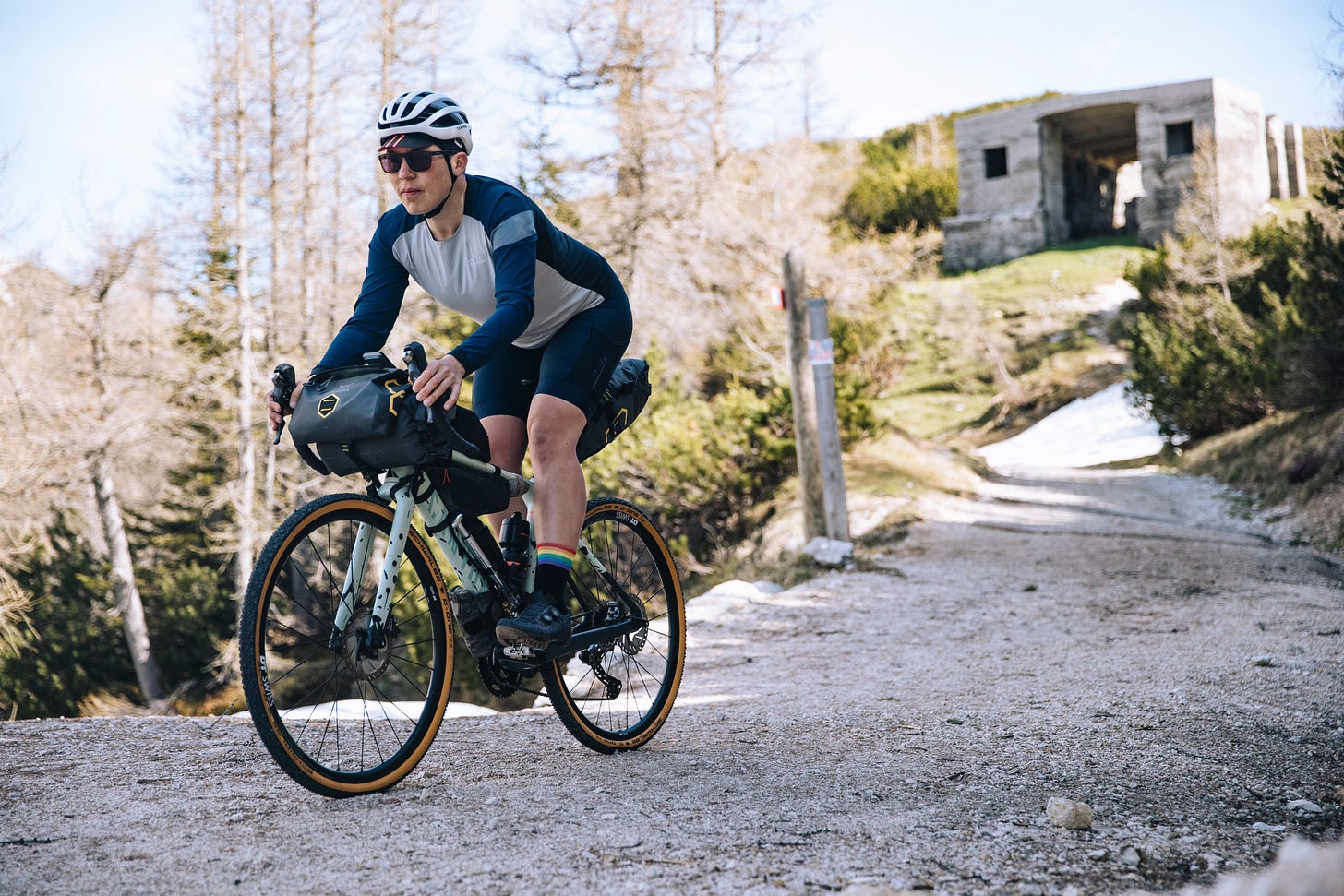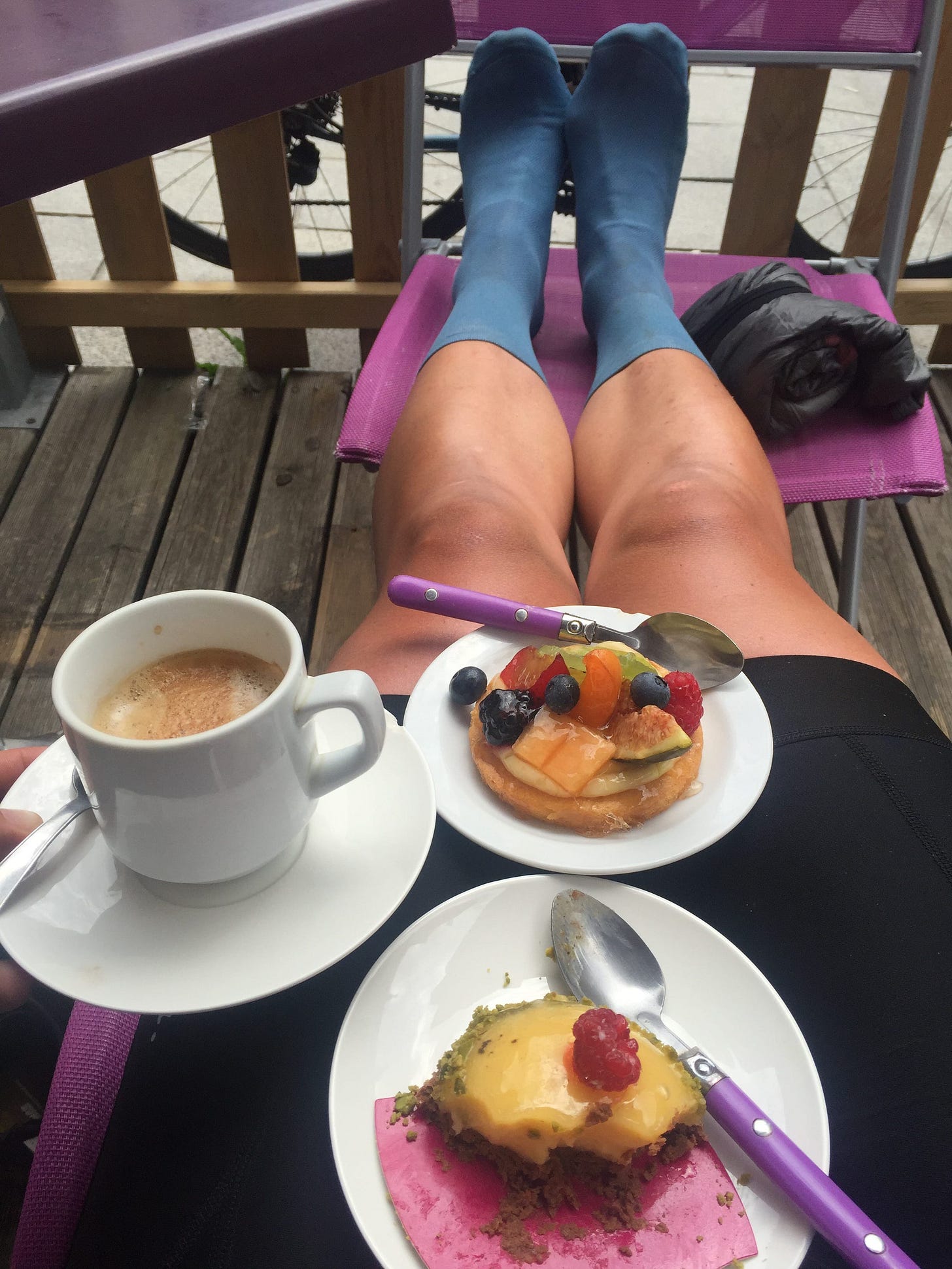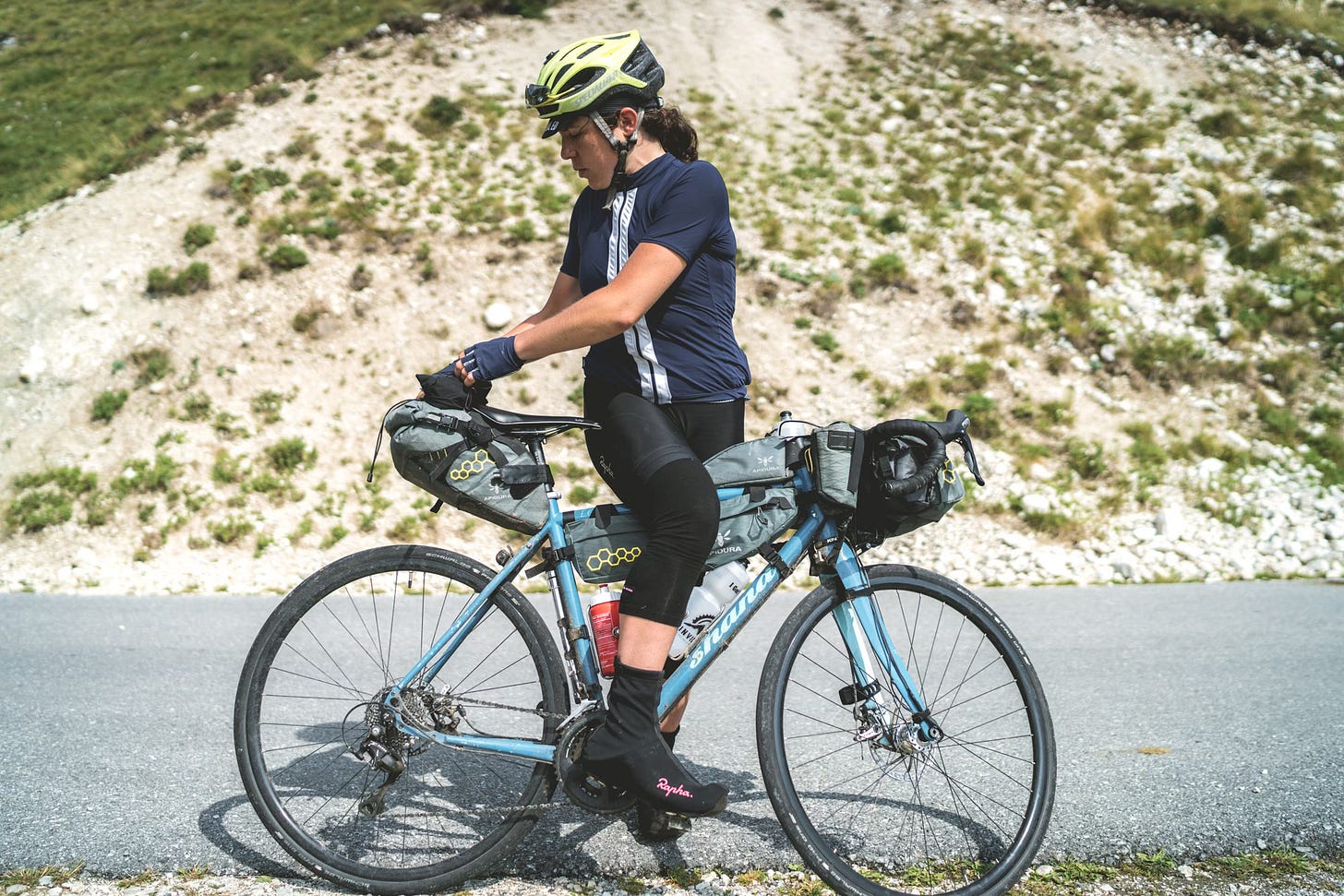Hello all,
Before I get going, just a reminder that this week I’ll be in Shrewsbury (on Wednesday) and Newport (on Thursday), doing events with Duncan Steer. Please do come along, if you’re in town, or tell your local friends if you’re not. All details (and tickets) via this link.
‘Tis the season.
And by that, I mean, the season where everyone’s getting either excited or nervous (or both, in many cases) about whatever big cycling challenge they’ve set themselves this summer. I know this because I’ve started to get regular messages from people, asking for advice and reassurance.
And I really want to help, despite suspecting that I’m not the best person to offer advice on this sort of thing. True, I have a certain amount of experience, but that only really makes me an expert in my own methods, and being part of the ultra-cycling community has taught me that there are as many different approaches and reactions to racing as there are racers.
I’m not very interested in tech, and I don’t think I have ever published a kit grid or a packing list – but countless other people have, and they’re available all over the internet, if that’s what you’re after.
There are also now a lot of people who have set themselves up as experts in the field of ultra-racing. I would particularly recommend Jasmijn Muller, who since retiring as one of the UK’s strongest time-triallists, has set herself up as a coach, specialising in long-distance and with a particular focus on women. She also runs training camps (with fellow coach Niel Copeland), which I suspect offer the most thorough introduction to ultra-cycling there is.
But, despite all of those disclaimers, I really don’t want people to stop asking me for advice. I love hearing about the adventures they’re planning, and I welcome any opportunity to talk about long-distance cycling, and all that I’ve learned while doing it.
So here’s a collection of some of my more obscure advice. It’s by no means exhaustive – and if you want detailed, specific and scientifically rigorous information on how to train, eat, dress, pack and avoid injuries, there are better places to look. But really I think a lot of us just want some friendly reassurance, and a few key points to remember as we go.
During my first few races, I carried pieces of advice friends had given me as if they were mascots or lucky charms. Whenever I followed someone’s advice I’d think of the care with which they had offered it, the admiration I had for them and the belief they seemed to have in me.
“Whenever you stop to eat or drink, order double,” Rickie Cotter told me, on some long bike ride we did in late 2015. And the next race I did, I thought of her every time I sat in a café, avoiding eye contact with the other patrons as I worked my way through two cappuccinos and two cakes.
“Make sure all your emotional breakdowns happen on the bike, rather than beside the road,” Mike Hall said, the first time I met him. So at times when it got really hard, I would ride along whimpering to myself, and imagine him doing the same. Somehow, this absurdity would always take the edge off whatever I was suffering, and remind me that that there would be a time beyond this agony, when I could tell Mike about what I had been through, and we would look back and laugh.
“If you’re not riding, eating or sleeping, you’re wasting your time.”
I can’t remember who told me this, and I suspect it was just some ultra-distance lore that I overheard in a conversation, or on Twitter. But this too reminded me that I wasn’t alone – that other people had done this sort of thing, and thought about how to make it less difficult. I felt benevolently overseen by them in the same way as I did the dotwatchers – and that, despite my naivety, I was part of something bigger than myself.
So the advice that follows is what I’d say to you if you asked me for reassurance about a big ride you had coming up. It’s how I’d show you that I care about you, I believe in you, and I want you to have an excellent time out there. None of it is the last word on the subject – it’s just what I think. You’ll get different answers from a professional coach, and from every other rider you ask. And to be honest, you probably know most of it already.
This is a free post – and I encourage you to forward it to anyone you know who is embarking on a big adventure this year, and might need to hear it.
Eat as much as you possibly can. Sometimes this will mean thousands of calories in a sitting; sometimes just one mouthful at a time. What you’re able to eat may vary wildly during your ride, especially if, like many riders, you’re prone to digestive upsets. Some days the most you can manage will be an occasional handful of Haribo. But if that’s as much as you can possibly eat, then eat it you must. And if, half a day later, your stomach will let a bit more in, then give it all it can comfortably take.
It's physically impossible to ingest enough calories to replace those expended during an ultra. So you will always be operating on a deficit, which means your poor body will be having to make hard decisions about where to send its limited energy. If you insist on working your leg muscles for 16 hours a day, then your body will have to compromise elsewhere, which will lead to all sorts of little things going wrong. (By the end of TCR I was covered in weird little spots and sores.)
So give your body as much help as you can. Listen to your cravings. Eat as much as you possibly can. And don’t stop once you’ve finished the race. You have serious catching up to do.
And on that note…
Ultra-distance cycling is not a reliable weight-loss strategy. To give you an example, I would often get very bloated during long rides, then look emaciated at the end, then gain weight rapidly over the subsequent weeks. I don’t think there’s anything wrong with this – my body was reacting, as best it could, to the truly unreasonable ordeal I had put it through. But if you have a complicated relationship with your body’s weight and size, you might want to bear this in mind.
I’m sure things will fluctuate differently for different people, and I often remind myself just how many vastly different physiques you’ll see on a start line, or at an Audax control. Every body has its own way of getting through a long bike ride. The best thing you can do is figure out how yours works, and then do whatever you can to enable it.
If you find a portable foodstuff that is 100% guaranteed to always work for you, carry a small stash for emergencies. I used to carry a Soreen malt loaf, which I was only allowed to eat in a crisis. On a similar note, I found chocolate-covered coffee beans helped me through the difficult period between getting up, and seeing the sunrise.
Listen to your body. You don’t always have to do what it says, but it’s useful to learn the difference between ordinary grumbling, and your entire nervous system screaming at you to stop.
And yes, I know listening to your body is a huge cliché, but I can think of several people I know who carried on riding with a sore knee/hip/bottom/back, because they really really didn’t want to quit, and as a result have had to give up riding long distances altogether. So keep listening, and think about your future rides, not just this one.
You can save yourself time and faff by thinking about where you pack things, and how often you’ll want to access them. The first time I raced TCR I kept my puncture kit in my top tube bag, which was completely pointless, and I eventually realised that it wasn’t something I’d ever want to take out and use as I was riding along, unlike, for example: snacks, my phone, medication, sunglasses, lip balm.
Over time I moved all these things up-front, so that I didn’t have to stop to get them out. And in my frame bag (the one between my legs), I put things like waterproofs, knee warmers and sun cream. I wouldn’t be trying to put these things on while I was riding along, but this way all I’d have to do is briefly put a foot down, and I could access them without getting off the bike.
My seat pack was mostly taken up by my sleeping bag, bivvy, and tools – things I’d only ever be using when I’d stopped the bike and got off it.
Don’t pack too tightly. If you really need to squeeze everything in to make it fit, consider adding an extra bag somewhere – because if your kit only just fits when it’s clean and dry and neatly folded, just imagine how impossible it will be to get it all in when you’re cold and grumpy, and you’ve just woken up from four hours’ sleep in a field, and everything’s wet, and your hands are stiff and numb and swollen.
Ideally do your packing a few weeks before the big day, and ride around with your bike in race mode for a while. (Or just do some rehearsal events with your full set-up.) This’ll help you get used to it, and iron out any minor flaws. I’m sure I don’t need to tell you that changing anything major (especially saddles and pedals) immediately before a big ride is asking for trouble.
Getting through cities always feels very slow. Don’t despair. But do make sure you are well fuelled and hydrated, and braced for a bit of stress.
And don’t plan to stop in a city, unless you really need to. Sure, there are plenty of shops and cafés, but they’re not usually worth the stress of worrying your bike will be nicked while you drink your second-rate cappuccinos. Out-of-town supermarkets and chain restaurants are usually a better bet, and places like McDonald’s usually won’t make a fuss if you bring your bike in.
Have a mental checklist for supermarket stops. And keep it thematic, rather than specific. If you’re feeling tired and dramatic, then you risk a meltdown when you discover they don’t have the particular brand of crisps you’ve been craving. Instead think in categories like ‘salty carbs’, ‘some sort of juice’, ‘hard cheese’, ‘snackable fruit’. And make a plan during your last few minutes of riding, otherwise you’ll waste time faffing.
Remove clothing whenever you get the chance. Your skin will thank you. And by this I mean, taking your shoes and socks off whenever you get off the bike for longer than a few minutes.1 Removing your gloves when you’re eating or drinking or shopping. Getting completely naked whenever you have a moment of privacy. Never, ever sleeping in your chamois. (I carry a small pair of merino shorts to change into when I’m bivvying.)
Don’t underestimate the morale-boost of washing your face and hands. (With cold water in summer, with hot water in winter.) To perk yourself up even more, clean your teeth.
Don’t go to pieces when you get to a hotel room. It’s so easy to close the door, breathe a huge sigh of relief, and then spend the next two hours lying on the bed in your filthy lycra, texting all your friends.
My rule is, the ride isn’t over until I’ve done all my admin – showered, washed my kit and hung it up to dry, plugged in all my devices, cleaned and refilled my bottles, fettled the bike, and anything else that needs doing.
If you put it off till after dinner, you’ll just get tireder and tireder, and end up cutting corners or forgetting things. If you put it off till the morning, you’ll end up leaving late. Do it all, straight away, then relax.
(This can be another occasion where a pre-written checklist comes in handy.)
Eat something during your last half hour on the bike. Don’t worry about spoiling your dinner, or even assume that dinner’s imminent. If you’re staying in pre-booked accommodation it might take a long time to find it and check yourself in. Then there’s all the post-ride admin (see above), and the time it will take to figure out what dinner is, and where to find it. The pizza you order might then take half an hour to arrive. There’s a lot of work ahead of you, and a lot of variables you can’t predict. Make sure you’re well fuelled.
After the adventure is over, consider taking a small break before going home. Because you’ll be physically and mentally exhausted, and going back to real life will feel overwhelming. If you possibly can, try to create a small airlock for yourself, either by spending a few days in the finish town, or by booking yourself a guesthouse somewhere that’s easy to get to. If a friend or partner is meeting you at the finish, have a small holiday together before you head back. Or go home, but spend a couple of days at someone else’s house before going back to your own.
It sounds like an extravagance, and it obviously won’t be possible for everyone, but on the occasions that I’ve managed to do something like this, even just for a couple of nights, it has really helped.
Accept that you will probably have a tough time for the first six weeks after the event. People talk about the post-trip blues, but somehow there’s a difference between knowing the risks, and being in the thick of it. Symptoms vary from person to person and race to race, but it’s common to feel seriously depressed for a while, to be fatigued, to have various aches and pains and ailments as your body repairs itself, to gain or lose weight2, and generally to feel like a pale shadow of the triumphant ultra-cycling hero you were until so very recently.
There’s no good advice for this, because you may well just feel awful for a few weeks, and the only solution is to take it easy, eat well, and give yourself plenty of time. You might worry that you’re permanently broken, but you’re almost certainly not. And the quickest way to regain your health, happiness, energy and love of cycling, is to (once again) let your body have what it wants – in this case, a good rest.
One thing I will say is: don’t make it worse by comparing yourself to all the people on social media who seem to be permanently on the go and never get tired. For a start, they’re only a small part of the full picture – the people who are in the same exhausted state as you probably aren’t posting. And as ever, you never know what’s really going on behind the photos. When I started talking about my long COVID a couple of years ago, I got messages from all sorts of unexpected people, saying they were in the same boat. Many of them still maintained a social media presence that very much suggested otherwise.
Finally, make sure you enjoy the event. It’s another huge cliché, but seriously – what’s the point in doing something like this if you’re not at least having Type 2 fun3? And if you do end up having to quit before the end (as huge numbers of ultra-cyclists do, for all sorts of legitimate and unavoidable reasons) you at least want to take home good memories, and perhaps the will to give it another go.
What’s the best advice you ever received about long-distance cycling? Is there anything you’d recommend to people who are gearing up for their first big event – or who are already very experienced, but always looking to learn more?
Let us know in the comments!
Until next week,
Emily
Carrying flip-flops, sliders or crocs is something I’ve never done on an ultra – but I’ve thought about it. They weigh very little, and the comfort value is HUGE. Crocs are also useful for river crossings, if it’s that sort of event.
Which obviously should not be considered a problem, but let’s not pretend that many of us don’t find it psychologically difficult.
Type 2 fun refers to activities that are difficult or miserable at the time, but fun in hindsight – like so much of ultra-racing. (Type 1 fun is just fun: fun at the time, fun to look back on. Type 3 fun is not fun at all, ever, even in hindsight.)







I recently enjoyed this piece by Brendan Leonard aka Semi-Rad:
https://semi-rad.com/2025/05/a-regular-persons-guide-to-surviving-an-ultramarathon/
While I am very much not an ultracyclist or ultramarathoner, I appreciated this snippet:
“If you feel bad, eat something. If you feel good, slow down.”
I'd be interested to know your take on this second point Emily - better to make hay while the sun shines, or to avoid burning all your matches too early?
I am very much not an ultracyclist, but eating in the last 30 minutes is a tip I think I'll try when out walking, as I'm always a useless mess as soon as I get home and it would be nice to be less of one. Thanks!